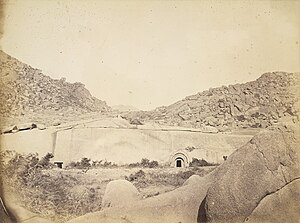Marabar Caves
This article has multiple issues. Please help or discuss these issues on the talk page. (Learn how and when to remove these template messages)
|

The Marabar Caves are fictional caves which appear in the novel A Passage to India and the film of the same name. The caves are based on the real life Barabar Caves located in the Jehanabad District of Bihar, India. They serve as an important plot location and motif in the novel. Key features of the caves are the glass-smooth walls and a peculiar resonant echo amplifying any sound made in the caves. Forster chose the caves to set a turning point in the novel. Not just for Adela, but also for Mrs Moore, Cyril Fielding and Dr Aziz the caves mark a turning point in the novel and their lives. The caves are significant because they mark the hollowness in the lives of the four main characters. None of them are getting what they want and are trying to find a balance in life amid expanding chaos.
Relevance in the novel[]
The main characters Mrs. Moore, Adela Quested, and Dr. Aziz are in a large group that journeys to the Marabar Caves. During the tour of the caves Adela, Dr. Aziz, and a local guide carry on separately from the group. Adela privately questions her love for Ronny, a British Civil Magistrate in Chandrapore. Assuming that the Muslim Dr. Aziz has multiple wives, she questions him about the nature of love. Rattled by the question, as his only wife has died, leaving two sons and a daughter, Dr. Aziz takes temporary leave of her to have a cigarette. Adela is attracted to him, though the feeling is not mutual. They realise simultaneously that a relationship is out of the question. When Adela enters a cave, her claustrophobia, as well as what some critics have assumed is a sexual desire for Aziz, and the consequent guilt over her lack of feeling for Ronny, combine to overwhelm her. She flees the caves down a steep incline and is pierced and lacerated by strongly thorned plants along the way. Adela manages to find someone at the bottom of the slopes who helps her to return to Chandrapore where she lodges a charge of molestation against Dr. Aziz. A trial ensues which is central to the novel's development of the cultural biases and conflicts that occur during the Raj. Later, during the trial, Adela overcomes the echo that has followed her from the caves and accepts her mistake. Aziz is released but he remains furious over the incident. The caves incident leads to a rift between these characters and Aziz starts believing he has been cheated by Fielding and Adela. He wants Adela to pay for the troubles she caused but Fielding persuades him to not to harass the poor girl further who made the mistake out of fear and confusion. This makes Aziz and other Muslims suspect Fielding and Adela and if they are in a relationship.
Mystery of the caves[]
What really happened inside those caves remains a mystery and no one discovers who really did the mischief. Aziz and Fielding suspect it was the guide, but nothing is conclusively proved. The caves are central to both the theme and the structure of the novel and add meaning to its plot. They also give the novel a definite tone. Forster calls India a muddle and uses the caves to explain the sense of mystery and muddle enveloping India. The caves remain mysterious and the echo haunts both Mrs Moore and Adela. The confusion born inside the caves destroys the equilibrium in people's personal lives and relationships.[1] Mrs Moore dies soon after the incident on her way back to England. Aziz remains suspicious of his friends, including Fielding and Adela Quested. He proceeds to reject Western influence to find solace among his own people and society. Marabar Caves and the myths born of them represent a unique side of the Indian culture and how it keeps people within their respective compartments. The caves represent, metaphorically, the rising movement in India for independence. Aziz's journey throughout the caves, and his subsequent trial, represent the development of nationalist and pro-independence ideals among the populace of India. The caves also symbolize the cosmic forces that remain prominent throughout the novel till the end.
References[]
- ^ Moran, Jo Ann Hoeppner. "E. M. Forster's A Passage to India: What Really Happened in the Caves". www.muse.jhu.edu. Retrieved 2018-01-04.
- Fictional subterranea